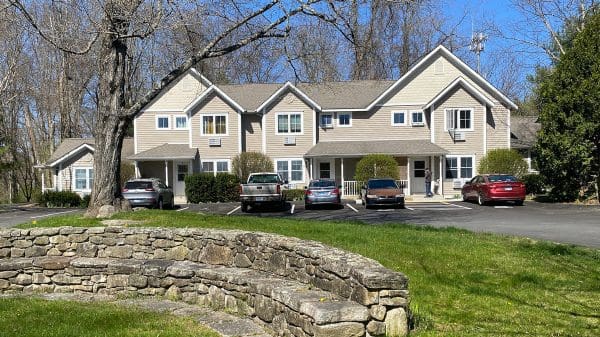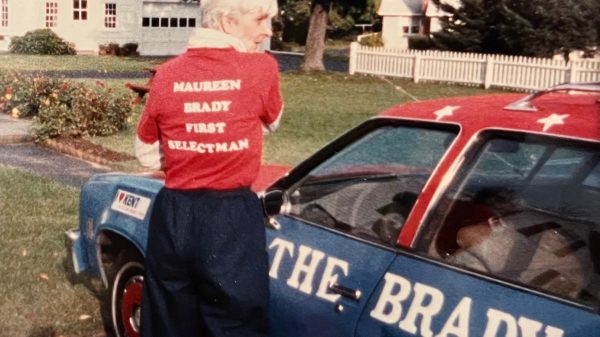KENT—Imagine this scenario: you are driving your electric vehicle along beautiful Route 7 late one summer afternoon when you suddenly notice that your car’s battery is virtually drained. Where can you get a quick charge to carry you on along your route?
That is exactly what happened to one motorist who visited Town Hall recently looking for assistance. There is only one EV charger located on public land between New Milford and North Canaan, a 50-minute drive. That charger is an older model on the campus of Town Hall that currently provides, at best, a trickle charge.

It is a situation that weighs on First Selectman Marty Lindenmayer’s mind. “This is a destination area, not just someplace people drive through,” Lindenmayer said this week. “We have to have more than one charger in town.”
It has turned his attention back to a grant program—the National Electric Vehicle Infrastructure Formula Program (NEVI)—enacted in 2021 to help increase the number of fast EV chargers along designated “Alternative Fuel Corridors” (AFCs). Connecticut has four AFCs, of which Route 7 is one. Approximately $52 million in funding was designated for Connecticut over the first five years of the program.
“We had looked into this grant earlier this year, but the spacing of the EV stations was such that none could be supported in Kent center under the original grant program,” he said. The requirements specified that four EV chargers be located “within one drivable mile from any exit or intersection along an AFC.”
The four-charger minimum makes it hard for many rural towns to find a location large enough for the project. If Kent cannot provide a spot, the next location is in Falls Village.
Now, a second phase of funding has opened, and Lindenmayer says he is investigating to see if a Level III station could be established within the community at some place such as the Welcome Center, the Kent Center School or perhaps near the firehouse.
Level III chargers would be a boon to travelers as they can charge an electric car in as little as 30 minutes. Slower chargers cost less but can take up to 12 hours to fully charge a vehicle. Level 1 chargers, for instance, are the most fundamental type of EV chargers, with a typical charging rate of around two to five miles of range per hour (RPH). They can plug into a standard, grounded 120V electrical outlet and are ideal for overnight charging at home or in a workplace, where drivers have ample time to charge the vehicle.
Level II chargers offer a speedier way to charge electric vehicles. With a charging speed of around 10 to 20 miles of RPH, Level II chargers can completely charge most electric vehicles in just a few hours, which is why currently they are the most widely used charger at public EV charging stations.
Level III chargers are by far the fastest, using direct current (DC) instead of alternating current (AC). The speed with which they can recharge a vehicle makes them a convenient choice for people who frequently travel long distances, but DC fast chargers are only compatible with select electric vehicles.
Currently, there are three different North American plug types for Level III chargers.
Towns across the nation are going to have to deal with the emerging popularity of electric vehicles. According to an Experian Automotive Market Trends report from the fourth quarter of 2023, there were about 3.3 million electric cars on the road in the U.S, up from 2 million electric vehicles in 2022 and 1.3 million in 2021.
Lindenmayer will ask the Conservation Commission to see if it can provide support for this grant.



























Elyse
July 25, 2024 at 1:03 pm
As an EV owner and driver for 6 years now, I am fully in support of this! Though, from experience, you don’t ever really “just realize” that you’re out of battery…
Bruce Adams
July 25, 2024 at 2:08 pm
Obviously this needs to be done. However, it is worth noting that when the charger at town hall was installed there was a fair amount of people complaining that “Who’s going to pay for my gas?” if we’re giving free electricity to EV owners. A valid point. But when we looked into adding a credit card reader the cost was high. Then the charger broke and we decided not to repair it .
As to possible locations for multiple units I’d suggest KVFD , the back of the Kent Town Center, or Kent Green if owner John Casey has a viable place.
Carl vR, Kent, CT
July 27, 2024 at 3:29 am
Many folks like myself think EVs are premature in today’s America. As produced currently, they depend on enormous quantities of battery ingredients that are owned almost exclusively by China. And, obviously, reliance on that regime is obtuse.
I hope that not another dime is spent to support EVs – in Kent, or anywhere – until technology evolves to where we can build clean vehicles sustainably, using American resources. Independence is paramount, more than ever.
Meanwhile, we have a first class fueling station right handy, open 7 days a week. Travelers can, as always, plan their outings accordingly.